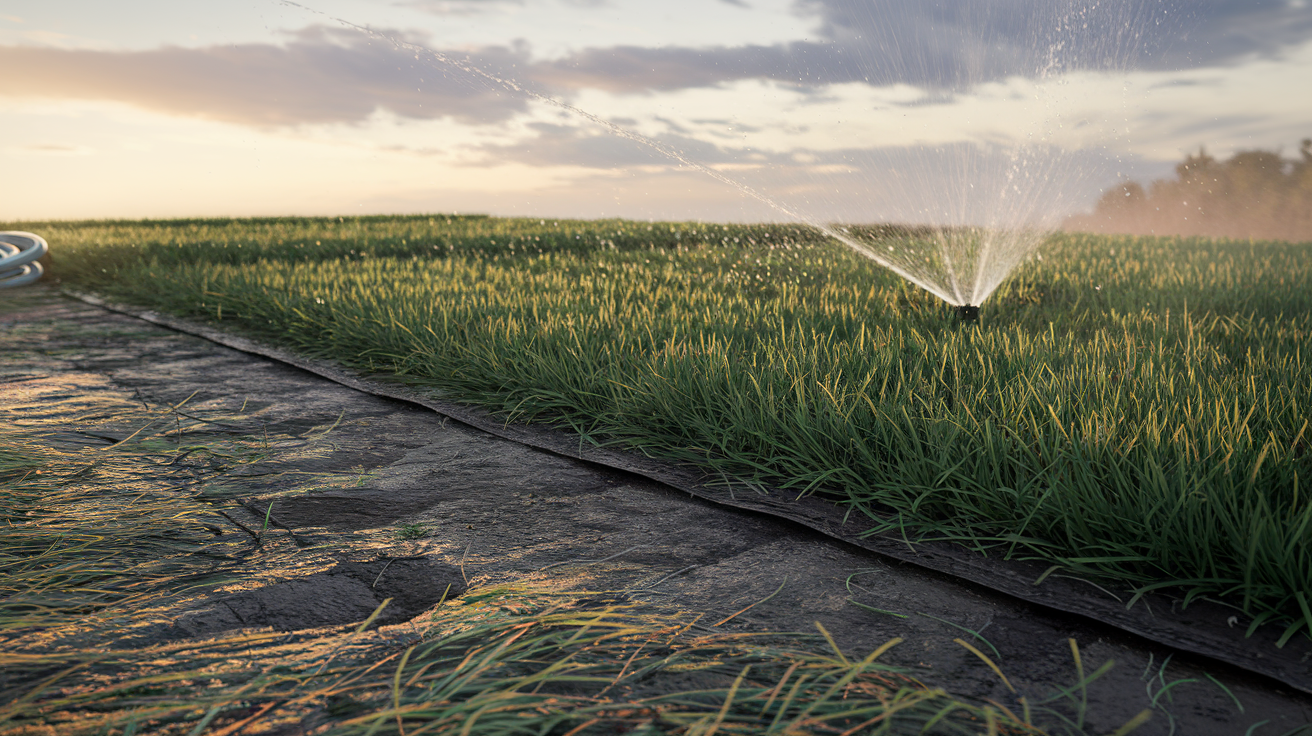
How Often Should You Water and Nurture New Sod?
Published on April 16, 2025 by Darryl Chevis
There's something satisfying about rolling out fresh sod--transforming a patchy, bare lawn into an instant carpet of green. But that instant gratification comes with responsibility. Your new sod is essentially in intensive care, disconnected from established roots and desperately needing the right care to survive. As someone who has both succeeded and failed with new sod installations, let me walk you through what your new lawn truly needs.
The Critical First Weeks
Week One: Intensive Care
The moment your sod touches your soil, it begins a race against dehydration. During the first week, your new lawn requires significant amounts of water--enough to keep both the sod and the soil beneath consistently moist. Water your new sod 2-3 times daily for the first 7-10 days, providing about 1-1.5 inches of water total each day. The best schedule typically includes:- Early morning (before 10 AM)
- Midday (around 2 PM)
- Late afternoon (around 5 PM, allowing some drying before nightfall)
Weeks Two and Three: Easing the Transition
As your sod begins developing new roots, you can gradually reduce watering frequency--but not amount. By days 8-14, aim to water deeply once or twice daily, providing the same total amount (about 1-1.5 inches), but in fewer sessions. By the third week, your sod should be developing stronger roots. Reduce to watering every other day, still delivering about 0.5-0.75 inches per session. This deeper, less frequent watering encourages roots to grow downward in search of moisture.Signs Your Watering Strategy Is Working
When properly watered, your sod will:- Maintain a vibrant green color
- Feel firmly attached when gently tugged (after about two weeks)
- Show no gaps between pieces
- Spring back when walked on
The Establishment Timeline
Full establishment doesn't happen overnight. Here's what to expect:Weeks 1-2: Root Initiation
New roots begin to grow downward into the soil. The sod pieces will still lift easily if pulled.Weeks 3-4: Root Development
Roots extend deeper. You'll notice increased resistance when you gently tug on the grass.Weeks 6-8: Partial Establishment
Most sod varieties will be partially established, allowing for the first mowing. Wait until your grass reaches about 3-4 inches in height.Months 3-4: Full Establishment
By this point, with proper care, your sod should be fully established with a robust root system reaching 4-6 inches deep. Now your watering can transition to a normal maintenance schedule of about 1 inch per week.Adjusting for Seasons and Climate
The watering guidelines above represent average conditions, but adjustments are necessary based on:Summer Installation
Increase frequency in extreme heat. I've found that newly laid sod in 90°F+ weather may need brief watering sessions up to 4 times daily for the first few days.Fall/Spring Installation
The cooler temperatures mean less evaporation, allowing you to water 1-2 times daily in the first week, then adjust downward.Winter Installation
In mild winter regions where dormant sod is installed, water requirements decrease significantly. One daily watering is typically sufficient, focusing on keeping the soil moist but not saturated.Beyond Watering: Complete Sod Care
Soil Preparation: The Foundation for Success
Before laying sod, proper soil preparation is crucial. Remove old grass, rocks, and debris. Till the soil to a depth of 4-6 inches and incorporate organic matter if your soil is poor. A soil test can identify specific amendments needed for your grass type. When preparing my backyard, I discovered a layer of construction clay just inches below the surface. Adding topsoil and organic matter before sodding made all the difference in root development compared to my hasty front yard installation.Traffic Restrictions
Limit foot traffic completely for the first 2-3 weeks. Even after roots begin establishing, minimize traffic for the first two months. When you must walk on new sod, place wooden boards down to distribute weight evenly and reduce soil compaction.Fertilization Timeline
Wait at least 4-6 weeks after installation before applying fertilizer. Premature fertilization can burn tender roots and create stress. When ready, use a starter fertilizer with higher phosphorus content to encourage root development. Follow up with a balanced nitrogen fertilizer after the first mowing.First Mowing: Timing Is Everything
Most sod varieties should reach 3-4 inches before the first cut. Set your mower blade high, removing no more than one-third of the grass height. Ensure your mower blades are sharp to prevent tearing the tender new grass. Bag clippings for the first few mowings to allow maximum sunlight to reach the developing grass.Common Watering Mistakes
Underwatering
Signs include:- Shrinking sod pieces with visible gaps
- Curling edges
- Discoloration (blue-gray before turning brown)
Overwatering
Look for:- Spongy, soggy soil
- Standing water
- Fungus or mushroom growth
- Foul odors from the soil
Testing Root Establishment
Around week three, gently pull up a corner of sod in an inconspicuous area. You should see white roots extending into the soil. If roots aren't visible or are minimal, your sod needs more time before reducing water.Troubleshooting New Sod Issues
Brown Spots
Causes may include:- Insufficient water contact (air pockets under sod)
- Soil compaction
- Pest activity
Shifting or Slipping Sod Pieces
Causes typically include:- Installation on slopes without proper securing
- Excessive water creating runoff
Yellowing Grass
Causes may include:- Shock from transplanting
- Poor soil-to-sod contact
- Excessive moisture in low spots
Final Thoughts
Establishing new sod is a front-loaded investment of time and attention that pays dividends for years. The first month is critical--requiring daily commitment--but this intensive care period gradually tapers off as your lawn becomes established. Remember, your weather conditions, soil type, and grass variety might require adjustments to these guidelines. Pay attention to how your specific lawn responds, and don't hesitate to adjust your watering schedule accordingly. With patience and proper watering, that initial investment transforms into a resilient, beautiful lawn that will thrive for years to come.Categories: Sod & Lawn Care

